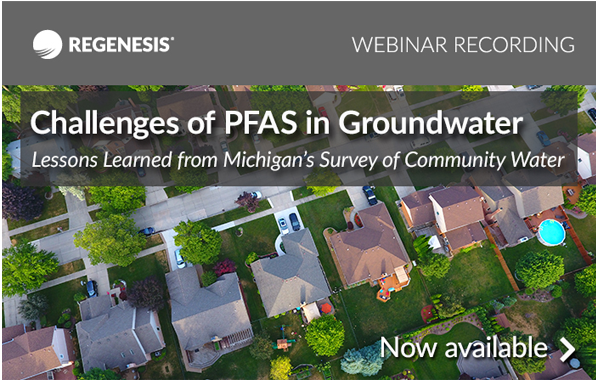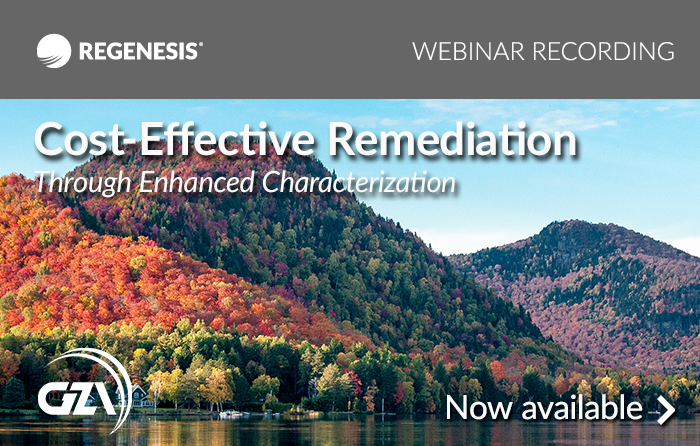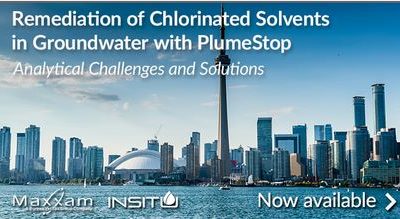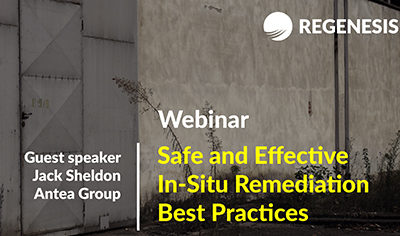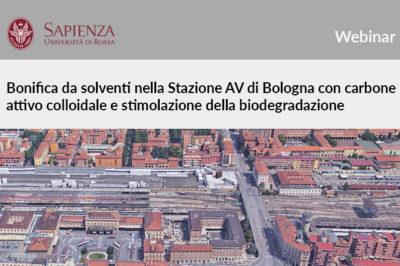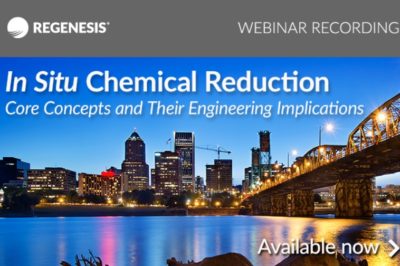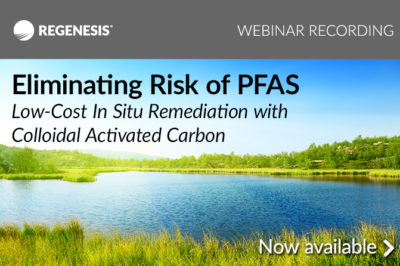Challenges of PFAS in Groundwater: Lessons Learned from Michigan’s Survey of Community Water
In this webinar we are pleased to have a special guest presentation by Steve Sliver of Michigan Department of Environmental Quality. Mr. Sliver will discuss challenges of PFAS in groundwater and lessons learned from Michigan’s survey of community water. Mr. Sliver is joined by Patricia Byrnes Lyman, Investigation/Remediation Manager at Michigan Dept of Military and Veterans Affairs, and Ryan Moore, Great Lakes District Manager at REGENESIS.
Learn the following in this free webinar:
- Discovery of unacceptable levels of emerging contaminants like per- and polyfluoroalkyl substances (PFAS) in a community water supply
- Immediate and longer-term actions to protect public health and ensure a reliable supply of safe drinking water
- Lessons learned during Michigan’s survey of all its community water supplies in 2018
View this free webinar
Two new remediation technologies for treating high contaminant concentrations in groundwater
First broadcast: 12 March, 2019
Speakers: Gareth Leonard, Managing Director Europe
This webinar introduces two brand new REGENESIS Technologies: Sulfidated micro-scale colloidal zero valent iron and dual function activated carbon technology for treating petroleum hydrocarbons. Both technologies are capable of dealing with high levels of groundwater contamination. We will focus firstly on S-MicroZVI™ − our new and innovative In Situ Chemical Reduction (ISCR) reagent that combines:
- colloidal ZVI (cZVI) particles for highly dispersibility
- sulfidated particle coating to increase activation and enhance longevity
- glycerol suspension to reduce passivation and provide ISCR-enhanced bioremediation
This exciting new development in zero valent iron treatment is especially effective for promoting the rapid biological degradation of chlorinated hydrocarbons, pesticides, haloalkanes, energetics and other toxic volatile organic compounds (CVOCs).
After which we introduce PetroFix™, a specially formulated activated carbon and electron acceptor amendment. PetroFix is designed to target petroleum hydrocarbon plumes and spills. Petrofix rapidly reduces the risk posed by residual contaminants by adsorbing petroleum hydrocarbons and stimulating their natural attenuation through syntrophic biological degradation. Applied by injection or directly into excavations, Petrofix can be used:
- as part of an active remedial strategy
- during an oil spill response to prevent the development of a plume or odours
- as a preventative measure within tank and pipe bedding – to mitigate against future leaks and spills
- on legacy sites, where active remedial systems cannot be operated
This webinar is useful to regulators, environmental consultants and remediation contractors and who are interested in increasing their remedial options for cost effective treatment of sites impacted with chlorinated solvents and petroleum hydrocarbons.
View the webinar recording
Cost-Effective Remediation through Enhanced Characterization
In this webinar we are pleased to have a special guest presentation by Richard Desrosiers, Associate Principal and Hydrogeologist at GZA GeoEnvironmental, Inc. In this presentation he discusses cost-effective remediation through enhanced characterization.
An in situ remediation case study is presented to demonstrate how enhanced characterization techniques were used to not only define existing conditions but also to define the upper and lower boundaries of two 4,000-foot plumes. A detailed understanding of subsurface conditions, including the factors influencing migration and natural attenuation, allowed the development of a source zone mass reduction remedial design, followed by a monitored natural attenuation approach for the downgradient portions of the plumes, rather than active remediation of the entire plume. Stoichiometric doses of PersulfOx (chlorinated plume) and a solution of lactic acid and 3DMe (hexavalent chromium plume) were injected within delineated zones of low and moderate hydraulic conductivity in those high mass zones to effectively reduce contaminant mass. Injection point spacing, and dosing were based on the calculated effective zone of influence of the additive, whereas, treatment barriers were based upon field pilot studies to determine the longevity of the additive and seepage velocities. Current data shows significant plume concentration/mass reductions within the two plumes.
View this free webinar
Remediation of Chlorinated Solvents in Groundwater with PlumeStop
First broadcast: December 03, 2018
Speakers: Dr. Heather Lord, Environmental Research & Development Manager for Maxxam Analytics and Rick McGregor, President of InSitu Remediation Services Ltd
In this webinar we are pleased to have a special guest presentation by Heather Lord PhD, Environmental Research & Development Manager for Maxxam Analytics. In this presentation she discusses analytical challenges and solutions when using PlumeStop Liquid Activated Carbon for in-situ remediation of chlorinated solvents in groundwater.
This webinar features discussion of:
- Current approaches for sampling and analysis of chlorinated solvents in groundwater samples that contain suspended carbon amendments.
- Pros and cons of the alternative approaches.
- Recommendations for sampling and sample submission.
Joining Heather Lord is Rick McGregor, President of InSitu Remediation Services Ltd, who shares case studies of sites using the analytical strategies discussed in Dr. Lord’s presentation.
About the presenter:
Heather Lord, PhD
Environmental Research & Development Manager, Maxxam
Heather Lord is the Environmental Research & Development Manager for Maxxam Analytics. She joined Maxxam Analytics in 2012 and works closely with both Maxxam staff and industry stakeholders to address new technical challenges and evolving industry needs. Heather’s focus is on bringing new and improved service offerings to market and reducing time and costs for field work and lab analysis. Heather earned her Ph.D. in Analytical Chemistry from the University of Waterloo in 2005 and has published over 50 scientific research papers on the subject. Her areas of expertise include petroleum forensics and biomarker analysis, PFAS and related compounds testing, passive sampling in water, drug testing, and development of new analytical technologies.
Rick McGregor
President, InSitu Remediation Services Ltd
Rick McGregor is the President of InSitu Remediation Services Ltd and has over 26 years’ experience in groundwater and soil assessment and remediation. Rick has worked in over 30 countries and has authored numerous papers on groundwater assessment and remediation. Rick holds a M.Sc. from the University of Waterloo in hydrogeology and geochemistry and is a Certified Ground Water Professional in Canada and the United States.
View the recording of this free webinar
Safe and Effective In Situ Remediation: Best Practices for Amendment Selection, Design and Project Execution
First broadcast: December 11, 2018
Speakers: Jack Sheldon, Senior Remediation Specialist at Antea Group
In this webinar we are pleased to have guest speaker Jack Sheldon, Senior Remediation Specialist at Antea Group. His presentation discusses using a Select/Design/Execute project checklist to apply remediation products safely and effectively. Data collection, adherence to details, and good field awareness are key themes stressed throughout the webinar. Using an actual remediation site previously supported by REGENESIS, an example checklist is used to demonstrate how to:
- Select a REGENESIS remediation product through a series of key criteria evaluations focused on remedial goals and site characteristics
- Design a remedial approach with the selected product screened using various criteria focused on site technical and logistical information
- Execute the field application of the design, screening from a logistical and health and safety standpoint
About the presenter:
Jack Sheldon
Senior Remediation Specialist, Antea Group
Jack Sheldon is a remediation expert with over 36 years of industry experience. He has specialised in the field application of various types of bioremediation and chemical oxidation/reduction systems. He has had personal involvement in 22 first-type remediation projects in the US, and international experience including dozens of remediation projects across Europe.
Mr. Sheldon has worked extensively in the field to determine chemical type and extent, prepared various environmental reports, and successfully managed numerous environmental projects and technology programs. His primary expertise has been in the identification and selection of remediation technologies for projects and the monitoring of those technologies. Through this process, Mr. Sheldon has designed, implemented, and supervised hundreds of treatability and pilot studies comparing technologies and determining their feasibility under simulated or actual site conditions.
View the webinar recording and download the ‘in situ remediation project checklist’
Bonifica da solventi nella Stazione AV di Bologna con carbone attivo colloidale e stimolazione della biodegradazione
First broadcast: November 21, 2018
Speakers: Prof. Marco Petrangeli Papini
Abbiamo effettuato un webinar con il Prof. Marco Petrangeli Papini dell’Università La Sapienza di Roma quale presentatore ospite.
Durante il webinar il Prof. Petrangeli ha illustrato nel dettaglio il caso di studio dell’intervento di bonifica della stazione Alta Velocità di Bologna Centrale, dove una contaminazione diffusa da solventi clorurati a basse concentrazioni è stata gestita con successo mediante l’iniezione in situ del carbone attivo colloidale PlumeStop® Liquid Activated CarbonTM a supporto della stimolazione biologica riduttiva potenziata mediante prodotti elettro-donatori.
Sono state oggetto di trattamento alcune porzioni del sito in corrispondenza di due acquiferi, di cui uno superficiale con caratteristiche di bassa permeabilità ed elevata eterogeneità, ed uno più profondo maggiormente permeabile ed omogeneo. L’intervento di REGENESIS, con una prova pilota eseguita nel 2015 a seguito di studi dettagliati a scala di laboratorio condotti presso l’Università La Sapienza, e con full scale realizzato nel 2016 e 2017, risulta il primo intervento europeo con tale tecnologia, ed entrerà a breve nella fase di collaudo per la certificazione di avvenuta bonifica. La presentazione illustra un inquadramento del sito dal punto di vista geologico/idrogeologico e dello stato di contaminazione, i risultati degli studi di laboratorio propedeutici all’identificazione della più appropriata strategia di bonifica, e discute quindi gli interventi realizzati in funzione delle condizioni sito-specifiche esistenti, e fornisce una valutazione di dettaglio dei risultati ottenuti.
Guarda la registrazione webinar
In Situ Chemical Reduction (ISCR): The Core Concepts and Their Engineering Implications
First broadcast: September 19, 2018
Speakers: Paul Tratnyek, PhD Professor, Oregon Health & Science University (OHSU)
In this webinar we are pleased to have a special guest presentation by Paul Tratnyek, PhD, Professor in the Division of Environmental and Biomolecular Systems (EBS) and Institute of Environmental Health (IEH), at the Oregon Health & Science University (OHSU). In this presentation he discusses in situ chemical reduction (ISCR), specifically with regard to its core concepts and their engineering implications. Recent groundwater remediation studies demonstrating that there can be an abiotic component to natural attenuation, together with the proliferation of remediation technologies like zero-valent iron, has led to the emergence of a general class of groundwater treatment processes known as “in situchemical reduction” (ISCR). As the field of ISCR matures, it is developing “core concepts” that link fundamental understanding of the controlling processes to technology performance in the field.
This webinar features discussion of:
- Exploration of several core conceptual issues related to ISCR
- How oxidation-reduction potential (ORP) is related to dechlorination rates
- What controls the amount of intermediate “stall” dechlorination products like dichloroethene and vinyl chloride
View the recording of this free webinar
About the presenter:
Paul Tratnyek, PhD
Professor, Oregon Health & Science University (OHSU)
Dr. Paul Tratnyek is Professor in the Division of Environmental and Biomolecular Systems (EBS) and Institute of Environmental Health (IEH), at the Oregon Health & Science University (OHSU). He received his PhD in Applied Chemistry from the Colorado School of Mines (CSM) in 1987; served as a National Research Council Postdoctoral Fellow at the U.S. Environmental Protection Agency Laboratory in Athens, GA (ERD-Athens) during 1988; and as a Research Associate at the Swiss Federal Institute for Water Resources and Water Pollution Control (EAWAG) from 1989 to 1991.
Dr. Tratnyek’s research concerns the physico-chemical processes that control the fate and effects of environmental substances, including minerals, metals (for remediation), organics (as contaminants), and nanoparticles (for remediation, as contaminants, and in biomedical applications). Dr. Tratnyek is best known for his work on the degradation of groundwater contaminants with zero-valent metals, but his interests extend to all aspects of contaminant reduction and oxidation (redox) in all aquatic media. Some of his recent work emphasizes the fate/remediation of emerging contaminants (e.g., nanoparticles and 1,2,3-trichloropropane) and next generation energetic compounds (e.g., DNAN).
Eliminating Risk of PFAS Contamination: Low-Cost In Situ Remediation with Colloidal Activated Carbon
First broadcast: September 05, 2018
Speakers: Scott Wilson, President & CEO of REGENESIS
In this webinar we are pleased to have a special presentation by Scott Wilson, President & CEO of REGENESIS. In this presentation he discusses eliminating risk of PFAS contamination in soil and groundwater via low-cost in situ remediation with colloidal activated carbon.
By coating flux zones of an aquifer with colloidal activated carbon, a permeable sorption barrier is created in situ, purifying groundwater as it passively migrates.
View the recording of this free webinar
Ottimizzazione degli interventi di bonifica in situ della falda utilizzando Ferro Zero Valente colloidale
First broadcast: July 17, 2018
Speakers: Marcello Carboni, Mediterranean District Manager
Ing. Marcello Carboni, District Manager di REGENESIS, presenterà un webinar in cui discuterà i vantaggi dell’utilizzo del ferro zero-valente (ZVI) quale potente strumento per il trattamento di terreni ed acque di falda contaminati da solventi clorurati, pesticidi e altre sostanze tossiche. Il successo degli interventi di bonifica in situ risiede nell’utilizzo di ammendanti che possono offrire una perfetta combinazione di reattività, persistenza e capacità di distribuzione uniforme. Il webinar discuterà come:
- il ZVI colloidale può fornire superfici specifiche elevate con cinetiche di reazione potenziate e allo stesso tempo promuovere percorsi di reazione con i solventi clorurati che possono bypassare la formazione di sottoprodotti tossici.
- il ZVI colloidale consente di ottenere una sospensione acquosa stabile di particelle di piccole dimensioni e può penetrare e attraversare il volume dei pori interconnessi di matrici sabbiose o similari. Rispetto ai prodotti ZVI di dimensioni al di sotto del micron, come il ferro zero-valente nanocristallino (NZVI), le particelle di 2 micrometri persistono per tempi maggiori.
- le particelle colloidali di ZVI sono compatibili e possono essere co-applicate con altri ammendanti, tra cui le sospensioni di carbone colloidale e la maggior parte dei substrati organici donatori di idrogeno.
- ricerche recenti suggeriscono che il ferro solfurato può promuovere una reattività accelerata con eteni ed etani clorurati.
Per registrarti a questo webinar gratuito, compila il form.
Cost-effective Approaches using Colloidal Zero Valent Iron for In Situ Groundwater Remediation
First broadcast: June 19, 2018
Speakers: John Freim, Ph.D., REGENESIS Director of Material Science
Recording Available| In this webinar we are pleased to have a special presentation from John Freim, Ph.D., REGENESIS Director of Materials Science. In his presentation, Dr. Freim discusses the benefits of using zero valent iron (ZVI) as a powerful remediation amendment that can decontaminate soil and groundwater containing chlorinated hydrocarbons, pesticides, and other toxic substances. Successful in situ remediation is predicated on using amendments offering a perfect combination of reactivity, the ability to distribute uniformly, and persistence.
The webinar addresses how:
- Colloidal ZVI provides high surface areas with enhanced reaction kinetics while also promoting reaction pathways with chlorinated hydrocarbons that can bypass the formation of toxic daughter products.
- Colloidal ZVI promotes stable aqueous suspensions with small particles and can fit within and pass through interconnected pore volume of sandy soils and similar environments. Compared to sub-micrometer ZVI products such as nanocrystalline zero valent iron (NZVI), 2 micrometer particles persist for longer timeframes.
- Colloidal ZVI particles are compatible with and can be co-applied with other amendments including colloidal carbon suspensions and most organic hydrogen donors.
- Recent research suggests that sulfidated iron can promote accelerated reactivity with chlorinated ethenes and ethanes.

 Americas
Americas Europe
Europe Français
Français Deutsch
Deutsch Italiano
Italiano Español
Español